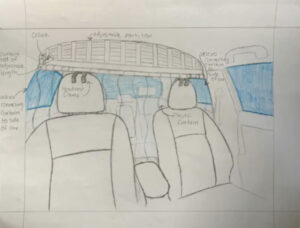
Hopkinton High School students Eleanor Nealon and Ceara Perry took second place in last month’s Hopkinvents Inventathon with their design for a barrier that allows for social distancing in a car.
Life in the time of COVID-19 has presented extraordinary challenges.
The creative minds of students who participated in the Hopkinvents Inventathon developed potential solutions to some of these issues during a 24-hour event that showcased problem-solving through invention.
A bracelet that responds to rising body temperatures — a potential sign of the virus. A divider that allows people to sit in separate rows of the same vehicle yet maintain safe social distance. A face shield that also can gauge a temperature and connect with contact tracing networks.
These were just some of the winning entries in the event, which was held virtually over a 24-hour period Jan. 15-16. The event was organized by Hopkinton High School students within the Business/Technology/Engineering Department.
Students wanted to run a virtual event to create and showcase inventions, said Doug Scott, Business/Technology/Engineering Department leader for Hopkinton schools, Grades 6-12. He supervised the Inventathon and oversaw the process as students developed the event.
The Inventathon’s timely focus was on solving problems related to COVID and school.
Scott hoped student participants would learn “how to properly identify a viable problem.” The next step, he said was to have students “utilize their youthful energy” to develop “unique solutions to real problems and realize that they can make a difference through the skills that they possess.”
Mentors and students taught each other, said Aryan Jinal Shah, who served as a mentor. “It doesn’t matter how old you are, everyone has something to teach someone,” Shah said. As mentors, “we shared our knowledge” but “we also learned a lot through the experience ourselves, even from the younger students.”
Shah credited “teamwork” with helping the event run smoothly. “Everyone is good at something different, and we worked together to make sure the students learned as much as possible while having fun,” he said.
Disha Mudenur, a freshman at HHS who served as a mentor, said she “walked away feeling amazing. Everyone who participated clearly enjoyed it, and those who organized it did too.”
Michael Youssef, an HHS senior, said that despite the challenges of developing such an event virtually rather than in person, students rose to the occasion.
“Both our high school and middle school participants were eager to put forth their creativity and diverse knowledge of art and engineering to solving problems,” he said. “Their passion and energy were clearly evident in the projects that they submitted.”
The results showed him the “insane amount of potential that many students in Hopkinton have in the field of engineering.”
Imaan Haider, an HHS senior and a mentor, enjoyed “seeing the participants learning and having fun while taking part in this event. I had fun planning and prepping for this, and I hope that I could help or participate in an event similar to this in the future.”
Invention education is crucial to growing the American economy, said Leigh Estabrooks, invention education officer with the Lemelson-MIT program, which advocates for invention education and helped to support the Inventathon.
Inventing “solutions to real-world problems” has never been more important, she said. The program advocates “all hands on deck” when it comes to invention education. “Girls invent, youth of color invent, rural youth invent, urban youth invent,” she said. “All youths must see themselves as inventors of our future’s health and well-being.”
The winners of the middle school competition were Dustin Ehwa and Rishith Ravi, both of Billerica. Taking second was Hopkinton’s Jacob Dold, and third place went to the Hopkinton duo of Chris Burton and Dylan Striek.
In the high school division, the team of Hopkinton’s Shishir Sudhaman and Billerica’s Christian So took first place. Eleanor Nealon and Ceara Perry, both from Hopkinton, took second. The Hopkinton duo of Sidhi Dhanda and Emily Kimball were third.














0 Comments